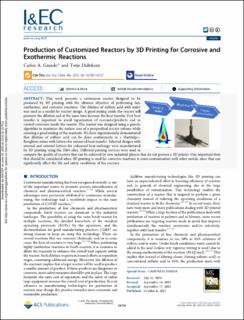| dc.contributor.author | Grande, Carlos Adolfo | |
| dc.contributor.author | Didriksen, Terje | |
| dc.date.accessioned | 2023-07-06T11:16:25Z | |
| dc.date.available | 2023-07-06T11:16:25Z | |
| dc.date.created | 2022-02-14T23:23:41Z | |
| dc.date.issued | 2021 | |
| dc.identifier.citation | Industrial & Engineering Chemistry Research. 2021, 60 (46), 16720-16727. | en_US |
| dc.identifier.issn | 0888-5885 | |
| dc.identifier.uri | https://hdl.handle.net/11250/3076564 | |
| dc.description.abstract | This work presents a continuous reactor designed to be produced by 3D printing with the ultimate objective of performing fast, exothermic, and corrosive reactions. The dilution of sulfuric acid with water was used as a model for reactor design. A good mixing inside the reactor will promote the dilution and at the same time increase the heat transfer. Fast heat transfer is important to avoid vaporization of reactants/products and to control corrosion inside the reactor. The reactor was designed using a genetic algorithm to maximize the surface area of a prespecified reactor volume while ensuring a good mixing of the reactants. We have experimentally demonstrated that dilution of sulfuric acid can be done continuously in a Hartridge− Roughton mixer with lattices for enhanced heat transfer. Selected designs with internal and external lattices for enhanced heat exchange were manufactured by 3D printing using the Ti64 alloy. Different printing services were used to compare the quality of reactors that can be achieved by new industrial players that do not possess a 3D printer. One important item that should be considered when 3D printing is used for corrosive reactions is cross-contamination with other metals, since that can significantly affect the life and safety conditions of the reactors. | en_US |
| dc.language.iso | eng | en_US |
| dc.publisher | ACS | en_US |
| dc.rights | Navngivelse 4.0 Internasjonal | * |
| dc.rights.uri | http://creativecommons.org/licenses/by/4.0/deed.no | * |
| dc.title | Production of Customized Reactors by 3D Printing for Corrosive and Exothermic Reactions | en_US |
| dc.type | Peer reviewed | en_US |
| dc.type | Journal article | en_US |
| dc.description.version | publishedVersion | en_US |
| dc.rights.holder | Copyright © 2021 The Authors. Published by American Chemical Society | en_US |
| dc.source.pagenumber | 16720-16727 | en_US |
| dc.source.volume | 60 | en_US |
| dc.source.journal | Industrial & Engineering Chemistry Research | en_US |
| dc.source.issue | 46 | en_US |
| dc.identifier.doi | 10.1021/acs.iecr.1c02791 | |
| dc.identifier.cristin | 2001588 | |
| cristin.ispublished | true | |
| cristin.fulltext | original | |
| cristin.qualitycode | 2 | |

